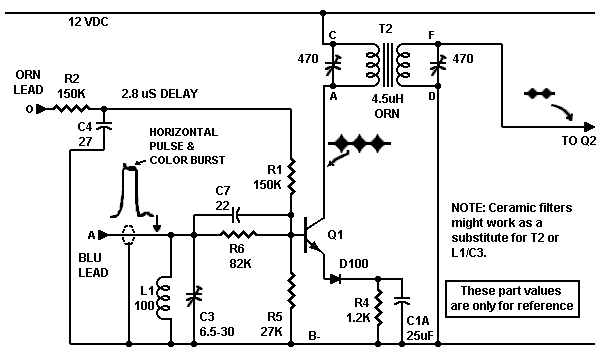Burst Amp Q1. The original Col-R-Tel circuit uses 6U8 tube V1 as a burst amplifier. The 6U8 is a dual tube. In our Col-R-Tel circuit, transistor Q1 replaces both halves of V1.
Col-R-Tel instructions require you to install a voltage divider. The divider parallels the host TV set's horizontal output tube.
This is the idea of the divider: During retrace, the divider samples the retrace pulse from the TV horizontal output tube plate. The pulse sample then gates the burst amplifier on. Due to Class-C bias, the burst amplifier only activates when it receives the retrace pulse.
|
|
|

Hazard. In a transistor set, paralleling the horizontal transistor might upset the retrace tuning. Worse still, the set might not be isolated from ground. Connecting to the horizontal circuit provides a route for high-voltage shocks and shorts. For these reasons, I don't recommend picking up horizontal pulses with a divider network.
Flyback winding. Instead, we acquire the horizontal pulse from an extra winding on the flyback transformer. About ten turns around the transformer should do the trick. (The flyback will induce a signal in any coil near the transformer.) The burst amplifier needs a signal with about 35 peak volts. This 30 to 40-volt pulse excites the Q1 base. Between retrace times, diode D100 at the Q1 emitter protects Q1 against negative pulses.
Delay network. The horizontal pulse enters our circuit through dividing network C4, R2 and R1. Resistor R2 and capacitor C4 delay the pulse. The delay causes the burst to coincide with the retrace pulse's back porch.
Between retrace pulses, the CRT displays our picture. One line of the picture appears during the horizontal sweep time period. Meanwhile, burst amplifier resistors R4 and R5 cut off transistor Q1.
Circuit L1-C3 tunes to 3.58 MHz. Through C24, R29 and C7, the color burst signal enters transistor Q1. At retrace, the Q1 base receives the positive horizontal pulse. This pulse gates Q1 on. Gating occurs as the pulse overcomes the reverse bias across R4 at the Q1 emitter. Transistor Q1 can now amplify the color burst on the horizontal sync pulse. (Parts C24 and R29 don't appear on the schematic from this page. These parts connect the burst section to the CRT. The connection goes to the CRT cathode driver through a yellow wire. See Part 6, Gun-Drive Circuit.)
Why do we gate? Gating is crucial because between bursts, L1 and C3 also couple the chroma signal. Chroma must not pass through the burst amplifier. Otherwise, synchronous detection can't occur. Gating keeps chroma out of the burst amplifier.
Transformer T2. In the Q1 collector circuit, transformer T2 tunes to 3.58 MHz. The burst easily passes through the transformer. The tuned transformer shears off the 15.75 kHz gating pulse.
Ceramic filter experiment. In an experiment, I'm replacing both the input and output tuned circuits with ceramic filters. These three-terminal filters might allow normal circuit operation without peaking adjustments!
Go to Page: 1 2 3 4 5 6 7 Next